February 26, 2010 at 2:29am
3 notes
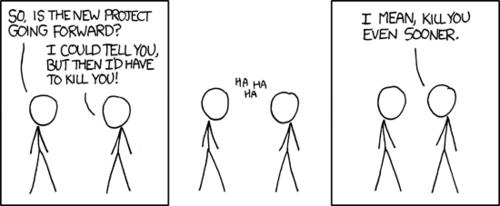
The man on the left asks the man on the right how his “new project” is going. It turns out that the project is a secret, and the man on the right uses the clichéd statement, “I could tell you, but then I’d have to kill you.” This causes the two men to laugh.
The man on the right (with the secret project) then corrects his previous statement by updating “kill you” to “kill you even sooner.” What this means is that the man on the right’s “secret project” was actually to kill a series of people, including the man on the left. By divulging this secret, he would be forced to kill the inquiring man earlier than scheduled, hence the addition of “sooner.”

The author pontificates on free will and the multitude of options we have as human beings in this, the 706th edition of his rigidly-scheduled web comic strip.
February 23, 2010 at 4:56pm
1 note
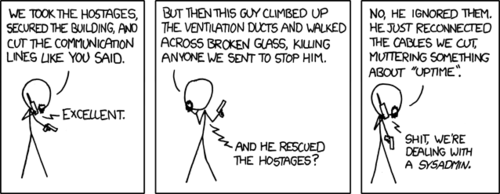
This comic is a reference to the 1988 action film Die Hard. The character with the life-like goatee is meant to be Hans Gruber, the film’s primary villain. The “guy” who is thwarting their efforts represents the protagonist, John McClane.
In the actual film, John does those same things described except in the end he saves the hostages. However in this retelling of the story, the hero instead repairs some cut cables in order to maintain “uptime,” a measure of the health of a computer network based on the percentage of time it’s functioning correctly. Through this decision to sacrifice human lives in order to keep a network online, the protagonist is easily identified as a systems administrator or “sysadmin.”
By boldly portraying a sysadmin as a heroic figure, the Author will surely boost the self-esteem of the many readers of his fine comic strip that happen to be in that line of work. For those that are not, this stark contrast simply serves as a humorous punch-line.
February 19, 2010 at 1:58am
6 notes
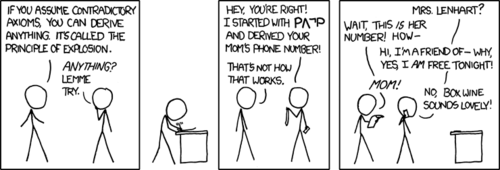
After following a few links off of the Tautology page on Wikipedia (see previous explanation), the Author’s creative talent was sparked once again on the Principle of Explosion page. It looks like Logic is a humor-rich mine, I hope we see some more jokes excavated soon!
The following comic is based off a misunderstanding of the Principle of Explosion, which claims that upon asserting a contradiction (a combination of two conflicting propositions), one can infer that any other proposition is true. In the comic, the Author has decided to replace “proposition” with “your mom’s phone number” (not a proposition, but a piece of information), possibly for humorous value. The character starts with the logical statement “P and not P” and derives a series of digits, which turns out to actually be the phone number of the other character’s mother.
Having gained an older woman’s phone number through the improper use of a logical device, the second character then calls her. In a shocking and quite humorous turn of events, the mother sets up a date with her son’s friend - much to the chagrin of her son. To wrap up this excellent punchline the Author mentions boxed wine, a well-known “funny beverage.”

In case you did not know: a tautology is a statement that is necessarily true, based only on the facts presented in the statement.
While applying for colleges, the author noticed the vague tautology of showing your honor by joining a club that shows you are honorable. With this keen observation, he invents a hypothetical and comical “tautology club.” This club’s activities, as seen in the last panel, consist of saying humorous tautologies at each other.
Also, the third member (from the left) of the club is Jason from the (non-web) comic strip FoxTrot.
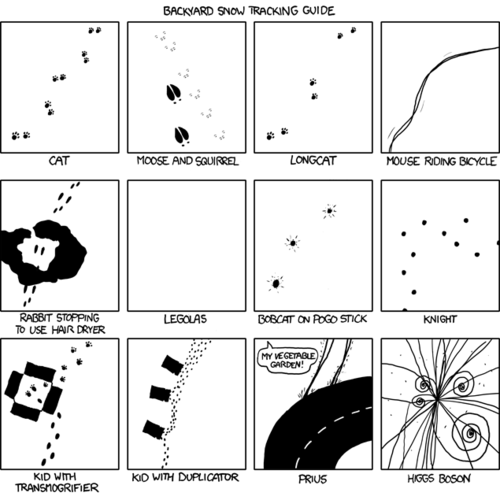
Here, various jokes are represented as a grid of animal footprint diagrams. In comic-book-reading order, with which you should have no trouble following, here are the explanations:
-
Cat Just a cat’s footprints - this non-joke is used as a foundation for the jokes that follow to build upon. If it helps, you may think of it as a “control group.”
-
Moose and squirrel A reference to children’s show The Rocky and Bullwinkle Show.
-
Longcat a reference to an internet meme of the “lolcat” variety.
-
Mouse riding Bicycle from The Mouse and the Motorcycle children’s series.
-
Rabbit stopping to use hair dryer It’s funny because rabbits don’t use hair dryers. It is also a setup for a homographic pun.
-
Legolas An “elf” from the Lord of the Rings movie series who leaves no footprints (get it?).
-
Bobcat on pogo stick Something random and wacky.
-
Knight The footprints move in the manner required of the knight piece in chess.
-
Kid with Transmogrifier A reference to the children’s comic Calvin and Hobbes.
-
Kid with Duplicator A reference to the children’s comic Calvin and Hobbes.
-
Prius A topical joke referencing the malfunction of the new Prius’ braking system.
-
Higgs Boson The tracks in this diagram resemble the output from the Large Hadron Collider that may prove the existence of the Higgs Boson particle.
In summary children’s series, lolcat, children’s series, homographic pun, Lord of the Rings, random/wacky, chess, children’s series, children’s series, topical joke and physics.
Note: you may consider the previous summary to be of this comic strip, or of the entirety of XKCD, the choice is yours.

I knew I was in for a real treat when I saw the title of this comic strip, “Science Valentine.” With gritted teeth and heavy breaths, I actually managed to read the entire thing. Now, poor reader, I will attempt to explain it.
The Author is not a scientist. He wishes that he was, but he is not and will never be one. It’s this desperate yearning that drives him to doodle fake graphs and charts that lack any data or substance behind them. He is a one-man cargo cult, playing out his ritual on the internet for hundreds of thousands to see.
This comic is a metaphor for the Author’s failed relationship with science. In it, the stick figure man is the Author and the receiver of the valentine is science. He begins the narrative by doing what he does best: sitting down and miming the work of a scientist. He draws some squiggly lines and writes down some numbers. But, the more he does this, the sadder he becomes. As hard has he tries, he can’t actually do any science. He couldn’t “defend the hypothesis” that he had an aptitude for science.
With this discovery, the Author officially ends his troubled relationship with science. It leaves one wondering, what is next for him? Will he still aimlessly draw “cute and funny” charts or graphs, or will they just remind him of this bitter break up? Will there be more observational humor about his perceived notion of the scientific method? Physics puns?
Without a girlfriend or science to keep him company at night, what will?

A male character decides to test the effectiveness of acne cream by applying it to only half of his face for a few weeks. Near the end of his trial, he decides to include some of his similarly disfigured friends in the experiment. To be extra-super-scientific about it he decides to randomly (through coin toss) choose who uses each type of cream. As he flips the coin, Batman yells “You!” and punches him in the face.
The reason batman did that is because the male character had acne on half of his face and was flipping a coin, so he looked like the villain Two-Face.
Don’t worry, calm down, there is still a graph in this comic strip. It’s right there in the first panel for some reason.
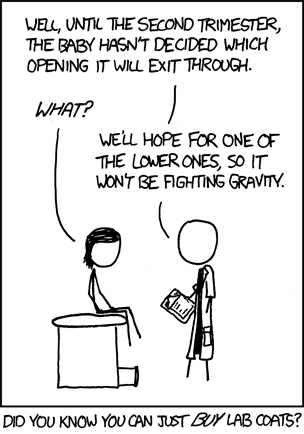
A man, presumably the Author, stands bedecked in the trappings of a doctor. He explains to a presumably pregnant woman that her unborn child “has not decided which opening it will exit through,” implying a dizzying array of choices. The woman, placed in the classic compromising position of trust that all females must face when their Obstetrician is male, is shocked as she tries to reconcile what she knows about her body with what the trusted patriarch is saying.
The caption delivers the punchline: an admission that the Author discovered how easy it was to deceive women at their most vulnerable moments. A simple bit of deception and he can cause untold confusion, doubt, and even fear in women.
This comic speaks to the darker nature of XKCD’s presentation of women. Underneath the consistent wheedling and ingratiation is a subtle need for control and dominance; a desire to control women by becoming co-dependent and pulling them into a cycle of obligation that is far easier to establish than a healthy relationship. These passive-aggressive shows of dominance are calculated to exert the most dominance while exposing the male to the least reproach, thus avoiding the deep fear of female disapproval that sits at the heart of many XKCD comics.
Curator’s Note: To make it perfectly clear to some of our dear readers who may be uncertain on matters of female reproduction: women cannot give birth through their mouth, sinuses, or anus.
12.









